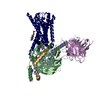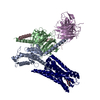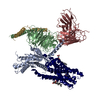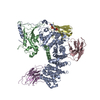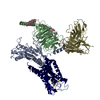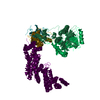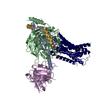+ データを開く
データを開く
- 基本情報
基本情報
| 登録情報 | データベース: EMDB / ID: EMD-23118 | |||||||||
|---|---|---|---|---|---|---|---|---|---|---|
| タイトル | Orexin Receptor 2 (OX2R) in Complex with G Protein and Natural Peptide-Agonist Orexin B (OxB) | |||||||||
 マップデータ マップデータ | ||||||||||
 試料 試料 |
| |||||||||
| 機能・相同性 |  機能・相同性情報 機能・相同性情報type 1 orexin receptor binding / type 2 orexin receptor binding / regulation of circadian sleep/wake cycle, wakefulness / circadian sleep/wake cycle process / orexin receptor activity / negative regulation of transmission of nerve impulse / Orexin and neuropeptides FF and QRFP bind to their respective receptors / positive regulation of transmission of nerve impulse / neuropeptide receptor activity / regulation of neurotransmitter secretion ...type 1 orexin receptor binding / type 2 orexin receptor binding / regulation of circadian sleep/wake cycle, wakefulness / circadian sleep/wake cycle process / orexin receptor activity / negative regulation of transmission of nerve impulse / Orexin and neuropeptides FF and QRFP bind to their respective receptors / positive regulation of transmission of nerve impulse / neuropeptide receptor activity / regulation of neurotransmitter secretion / neuropeptide hormone activity / sleep / positive regulation of calcium ion transport / : / feeding behavior / locomotion / temperature homeostasis / eating behavior / negative regulation of DNA replication / response to starvation / negative regulation of potassium ion transport / peptide hormone binding / neuropeptide signaling pathway / rough endoplasmic reticulum / cellular response to hormone stimulus / regulation of cytosolic calcium ion concentration / excitatory postsynaptic potential / secretory granule / peptide binding / Olfactory Signaling Pathway / Activation of the phototransduction cascade / G beta:gamma signalling through PLC beta / Presynaptic function of Kainate receptors / Thromboxane signalling through TP receptor / G-protein activation / G protein-coupled acetylcholine receptor signaling pathway / Activation of G protein gated Potassium channels / Inhibition of voltage gated Ca2+ channels via Gbeta/gamma subunits / Prostacyclin signalling through prostacyclin receptor / Glucagon signaling in metabolic regulation / G beta:gamma signalling through CDC42 / ADP signalling through P2Y purinoceptor 12 / G beta:gamma signalling through BTK / Synthesis, secretion, and inactivation of Glucagon-like Peptide-1 (GLP-1) / Sensory perception of sweet, bitter, and umami (glutamate) taste / photoreceptor disc membrane / Adrenaline,noradrenaline inhibits insulin secretion / Glucagon-type ligand receptors / Vasopressin regulates renal water homeostasis via Aquaporins / G alpha (z) signalling events / cellular response to catecholamine stimulus / Glucagon-like Peptide-1 (GLP1) regulates insulin secretion / ADORA2B mediated anti-inflammatory cytokines production / sensory perception of taste / ADP signalling through P2Y purinoceptor 1 / adenylate cyclase-activating dopamine receptor signaling pathway / G beta:gamma signalling through PI3Kgamma / cellular response to prostaglandin E stimulus / Cooperation of PDCL (PhLP1) and TRiC/CCT in G-protein beta folding / GPER1 signaling / G-protein beta-subunit binding / Inactivation, recovery and regulation of the phototransduction cascade / heterotrimeric G-protein complex / G alpha (12/13) signalling events / extracellular vesicle / signaling receptor complex adaptor activity / synaptic vesicle / Thrombin signalling through proteinase activated receptors (PARs) / GTPase binding / retina development in camera-type eye / phospholipase C-activating G protein-coupled receptor signaling pathway / Ca2+ pathway / positive regulation of cold-induced thermogenesis / positive regulation of cytosolic calcium ion concentration / G alpha (i) signalling events / fibroblast proliferation / G alpha (s) signalling events / postsynapse / G alpha (q) signalling events / chemical synaptic transmission / cell population proliferation / Ras protein signal transduction / Extra-nuclear estrogen signaling / G protein-coupled receptor signaling pathway / lysosomal membrane / GTPase activity / synapse / protein-containing complex binding / perinuclear region of cytoplasm / signal transduction / extracellular exosome / extracellular region / membrane / plasma membrane / cytoplasm / cytosol 類似検索 - 分子機能 | |||||||||
| 生物種 |  Homo sapiens (ヒト) / Homo sapiens (ヒト) /  | |||||||||
| 手法 | 単粒子再構成法 / クライオ電子顕微鏡法 / 解像度: 3.2 Å | |||||||||
 データ登録者 データ登録者 | Hong C / Byrne NJ / Zamlynny B / Tummala S / Xiao L / Shipman JM / Partridge AT / Minnick C / Breslin MJ / Rudd MT ...Hong C / Byrne NJ / Zamlynny B / Tummala S / Xiao L / Shipman JM / Partridge AT / Minnick C / Breslin MJ / Rudd MT / Stachel SJ / Rada VL / Kern JC / Armacost KA / Hollingsworth SA / O'Brien JA / Hall DL / McDonald TP / Strickland C / Brooun A / Soisson SM / Hollenstein K | |||||||||
 引用 引用 |  ジャーナル: Nat Commun / 年: 2021 ジャーナル: Nat Commun / 年: 2021タイトル: Structures of active-state orexin receptor 2 rationalize peptide and small-molecule agonist recognition and receptor activation. 著者: Chuan Hong / Noel J Byrne / Beata Zamlynny / Srivanya Tummala / Li Xiao / Jennifer M Shipman / Andrea T Partridge / Christina Minnick / Michael J Breslin / Michael T Rudd / Shawn J Stachel / ...著者: Chuan Hong / Noel J Byrne / Beata Zamlynny / Srivanya Tummala / Li Xiao / Jennifer M Shipman / Andrea T Partridge / Christina Minnick / Michael J Breslin / Michael T Rudd / Shawn J Stachel / Vanessa L Rada / Jeffrey C Kern / Kira A Armacost / Scott A Hollingsworth / Julie A O'Brien / Dawn L Hall / Terrence P McDonald / Corey Strickland / Alexei Brooun / Stephen M Soisson / Kaspar Hollenstein /  要旨: Narcolepsy type 1 (NT1) is a chronic neurological disorder that impairs the brain's ability to control sleep-wake cycles. Current therapies are limited to the management of symptoms with modest ...Narcolepsy type 1 (NT1) is a chronic neurological disorder that impairs the brain's ability to control sleep-wake cycles. Current therapies are limited to the management of symptoms with modest effectiveness and substantial adverse effects. Agonists of the orexin receptor 2 (OXR) have shown promise as novel therapeutics that directly target the pathophysiology of the disease. However, identification of drug-like OXR agonists has proven difficult. Here we report cryo-electron microscopy structures of active-state OXR bound to an endogenous peptide agonist and a small-molecule agonist. The extended carboxy-terminal segment of the peptide reaches into the core of OXR to stabilize an active conformation, while the small-molecule agonist binds deep inside the orthosteric pocket, making similar key interactions. Comparison with antagonist-bound OXR suggests a molecular mechanism that rationalizes both receptor activation and inhibition. Our results enable structure-based discovery of therapeutic orexin agonists for the treatment of NT1 and other hypersomnia disorders. | |||||||||
| 履歴 |
|
- 構造の表示
構造の表示
| ムービー |
 ムービービューア ムービービューア |
|---|---|
| 構造ビューア | EMマップ:  SurfView SurfView Molmil Molmil Jmol/JSmol Jmol/JSmol |
| 添付画像 |
- ダウンロードとリンク
ダウンロードとリンク
-EMDBアーカイブ
| マップデータ |  emd_23118.map.gz emd_23118.map.gz | 73.5 MB |  EMDBマップデータ形式 EMDBマップデータ形式 | |
|---|---|---|---|---|
| ヘッダ (付随情報) |  emd-23118-v30.xml emd-23118-v30.xml emd-23118.xml emd-23118.xml | 24.6 KB 24.6 KB | 表示 表示 |  EMDBヘッダ EMDBヘッダ |
| 画像 |  emd_23118.png emd_23118.png | 164 KB | ||
| アーカイブディレクトリ |  http://ftp.pdbj.org/pub/emdb/structures/EMD-23118 http://ftp.pdbj.org/pub/emdb/structures/EMD-23118 ftp://ftp.pdbj.org/pub/emdb/structures/EMD-23118 ftp://ftp.pdbj.org/pub/emdb/structures/EMD-23118 | HTTPS FTP |
-検証レポート
| 文書・要旨 |  emd_23118_validation.pdf.gz emd_23118_validation.pdf.gz | 401.9 KB | 表示 |  EMDB検証レポート EMDB検証レポート |
|---|---|---|---|---|
| 文書・詳細版 |  emd_23118_full_validation.pdf.gz emd_23118_full_validation.pdf.gz | 401.4 KB | 表示 | |
| XML形式データ |  emd_23118_validation.xml.gz emd_23118_validation.xml.gz | 6.4 KB | 表示 | |
| CIF形式データ |  emd_23118_validation.cif.gz emd_23118_validation.cif.gz | 7.3 KB | 表示 | |
| アーカイブディレクトリ |  https://ftp.pdbj.org/pub/emdb/validation_reports/EMD-23118 https://ftp.pdbj.org/pub/emdb/validation_reports/EMD-23118 ftp://ftp.pdbj.org/pub/emdb/validation_reports/EMD-23118 ftp://ftp.pdbj.org/pub/emdb/validation_reports/EMD-23118 | HTTPS FTP |
-関連構造データ
- リンク
リンク
| EMDBのページ |  EMDB (EBI/PDBe) / EMDB (EBI/PDBe) /  EMDataResource EMDataResource |
|---|---|
| 「今月の分子」の関連する項目 |
- マップ
マップ
| ファイル |  ダウンロード / ファイル: emd_23118.map.gz / 形式: CCP4 / 大きさ: 103 MB / タイプ: IMAGE STORED AS FLOATING POINT NUMBER (4 BYTES) ダウンロード / ファイル: emd_23118.map.gz / 形式: CCP4 / 大きさ: 103 MB / タイプ: IMAGE STORED AS FLOATING POINT NUMBER (4 BYTES) | ||||||||||||||||||||||||||||||||||||||||||||||||||||||||||||
|---|---|---|---|---|---|---|---|---|---|---|---|---|---|---|---|---|---|---|---|---|---|---|---|---|---|---|---|---|---|---|---|---|---|---|---|---|---|---|---|---|---|---|---|---|---|---|---|---|---|---|---|---|---|---|---|---|---|---|---|---|---|
| ボクセルのサイズ | X=Y=Z: 0.84 Å | ||||||||||||||||||||||||||||||||||||||||||||||||||||||||||||
| 密度 |
| ||||||||||||||||||||||||||||||||||||||||||||||||||||||||||||
| 対称性 | 空間群: 1 | ||||||||||||||||||||||||||||||||||||||||||||||||||||||||||||
| 詳細 | EMDB XML:
CCP4マップ ヘッダ情報:
| ||||||||||||||||||||||||||||||||||||||||||||||||||||||||||||
-添付データ
- 試料の構成要素
試料の構成要素
-全体 : Orexin Receptor 2 (OX2R) in Complex with G Protein and Natural Pe...
| 全体 | 名称: Orexin Receptor 2 (OX2R) in Complex with G Protein and Natural Peptide-Agonist Orexin B (OxB) |
|---|---|
| 要素 |
|
-超分子 #1: Orexin Receptor 2 (OX2R) in Complex with G Protein and Natural Pe...
| 超分子 | 名称: Orexin Receptor 2 (OX2R) in Complex with G Protein and Natural Peptide-Agonist Orexin B (OxB) タイプ: complex / ID: 1 / 親要素: 0 / 含まれる分子: #1-#5 |
|---|---|
| 由来(天然) | 生物種:  Homo sapiens (ヒト) Homo sapiens (ヒト) |
-分子 #1: Engineered Guanine nucleotide-binding protein subunit alpha
| 分子 | 名称: Engineered Guanine nucleotide-binding protein subunit alpha タイプ: protein_or_peptide / ID: 1 / コピー数: 1 / 光学異性体: LEVO |
|---|---|
| 由来(天然) | 生物種:  Homo sapiens (ヒト) Homo sapiens (ヒト) |
| 分子量 | 理論値: 28.040881 KDa |
| 組換発現 | 生物種:  |
| 配列 | 文字列: GTLSAEDKAA VERSKMIEKQ LQKDKQVYRR TLRLLLLGAD NSGKSTIVKQ MRILHGGSGG SGGTSGIFET KFQVDKVNFH MFDVGGQRD ERRKWIQCFN DVTAIIFVVD SSDYNRLQEA LNDFKSIWNN RWLRTISVIL FLNKQDLLAE KVLAGKSKIE D YFPEFARY ...文字列: GTLSAEDKAA VERSKMIEKQ LQKDKQVYRR TLRLLLLGAD NSGKSTIVKQ MRILHGGSGG SGGTSGIFET KFQVDKVNFH MFDVGGQRD ERRKWIQCFN DVTAIIFVVD SSDYNRLQEA LNDFKSIWNN RWLRTISVIL FLNKQDLLAE KVLAGKSKIE D YFPEFARY TTPEDATPEP GEDPRVTRAK YFIRKEFVDI STASGDGRHI CYPHFTCAVD TENARRIFND CKDIILQMNL RE YNLV |
-分子 #2: Guanine nucleotide-binding protein G(I)/G(S)/G(T) subunit beta-1
| 分子 | 名称: Guanine nucleotide-binding protein G(I)/G(S)/G(T) subunit beta-1 タイプ: protein_or_peptide / ID: 2 / コピー数: 1 / 光学異性体: LEVO |
|---|---|
| 由来(天然) | 生物種:  Homo sapiens (ヒト) Homo sapiens (ヒト) |
| 分子量 | 理論値: 38.579148 KDa |
| 組換発現 | 生物種:  Trichoplusia ni (イラクサキンウワバ) Trichoplusia ni (イラクサキンウワバ) |
| 配列 | 文字列: MGHHHHHHHH SELDQLRQEA EQLKNQIRDA RKACADATLS QITNNIDPVG RIQMRTRRTL RGHLAKIYAM HWGTDSRLLV SASQDGKLI IWDSYTTNKV HAIPLRSSWV MTCAYAPSGN YVACGGLDNI CSIYNLKTRE GNVRVSRELA GHTGYLSCCR F LDDNQIVT ...文字列: MGHHHHHHHH SELDQLRQEA EQLKNQIRDA RKACADATLS QITNNIDPVG RIQMRTRRTL RGHLAKIYAM HWGTDSRLLV SASQDGKLI IWDSYTTNKV HAIPLRSSWV MTCAYAPSGN YVACGGLDNI CSIYNLKTRE GNVRVSRELA GHTGYLSCCR F LDDNQIVT SSGDTTCALW DIETGQQTTT FTGHTGDVMS LSLAPDTRLF VSGACDASAK LWDVREGMCR QTFTGHESDI NA ICFFPNG NAFATGSDDA TCRLFDLRAD QELMTYSHDN IICGITSVSF SKSGRLLLAG YDDFNCNVWD ALKADRAGVL AGH DNRVSC LGVTDDGMAV ATGSWDSFLK IWN |
-分子 #3: Guanine nucleotide-binding protein G(I)/G(S)/G(O) subunit gamma-2
| 分子 | 名称: Guanine nucleotide-binding protein G(I)/G(S)/G(O) subunit gamma-2 タイプ: protein_or_peptide / ID: 3 / コピー数: 1 / 光学異性体: LEVO |
|---|---|
| 由来(天然) | 生物種:  Homo sapiens (ヒト) Homo sapiens (ヒト) |
| 分子量 | 理論値: 7.845078 KDa |
| 組換発現 | 生物種:  Trichoplusia ni (イラクサキンウワバ) Trichoplusia ni (イラクサキンウワバ) |
| 配列 | 文字列: MASNNTASIA QARKLVEQLK MEANIDRIKV SKAAADLMAY CEAHAKEDPL LTPVPASENP FREKKFFSAI L |
-分子 #4: single-chain antibody Fv fragment (svFv16)
| 分子 | 名称: single-chain antibody Fv fragment (svFv16) / タイプ: protein_or_peptide / ID: 4 / コピー数: 1 / 光学異性体: LEVO |
|---|---|
| 由来(天然) | 生物種:  |
| 分子量 | 理論値: 26.610615 KDa |
| 組換発現 | 生物種:  |
| 配列 | 文字列: GSDVQLVESG GGLVQPGGSR KLSCSASGFA FSSFGMHWVR QAPEKGLEWV AYISSGSGTI YYADTVKGRF TISRDDPKNT LFLQMTSLR SEDTAMYYCV RSIYYYGSSP FDFWGQGTTL TVSSGGGGSG GGGSGGGGSD IVMTQATSSV PVTPGESVSI S CRSSKSLL ...文字列: GSDVQLVESG GGLVQPGGSR KLSCSASGFA FSSFGMHWVR QAPEKGLEWV AYISSGSGTI YYADTVKGRF TISRDDPKNT LFLQMTSLR SEDTAMYYCV RSIYYYGSSP FDFWGQGTTL TVSSGGGGSG GGGSGGGGSD IVMTQATSSV PVTPGESVSI S CRSSKSLL HSNGNTYLYW FLQRPGQSPQ LLIYRMSNLA SGVPDRFSGS GSGTAFTLTI SRLEAEDVGV YYCMQHLEYP LT FGAGTKL ELK |
-分子 #5: Hypocretin receptor type 2
| 分子 | 名称: Hypocretin receptor type 2 / タイプ: protein_or_peptide / ID: 5 / コピー数: 1 / 光学異性体: LEVO |
|---|---|
| 由来(天然) | 生物種:  Homo sapiens (ヒト) Homo sapiens (ヒト) |
| 分子量 | 理論値: 43.470875 KDa |
| 組換発現 | 生物種:  Homo sapiens (ヒト) Homo sapiens (ヒト) |
| 配列 | 文字列: DYKDDDAMGT KLEDSPPCRN WSSASELNET QEPFLNPTDY DDEEFLRYLW REYLHPKEYE WVLIAGYIIV FVVALIGNVL VCVAVWKNH HMRTVTNYFI VNLSLADVLV TITCLPATLV VDITETWFFG QSLCKVIPYL QTVSVSVSVL TLSCIALDRW Y AICHPLMF ...文字列: DYKDDDAMGT KLEDSPPCRN WSSASELNET QEPFLNPTDY DDEEFLRYLW REYLHPKEYE WVLIAGYIIV FVVALIGNVL VCVAVWKNH HMRTVTNYFI VNLSLADVLV TITCLPATLV VDITETWFFG QSLCKVIPYL QTVSVSVSVL TLSCIALDRW Y AICHPLMF KSTAKRARNS IVIIWIVSCI IMIPQAIVME CSTVFPGLAN KTTLFTVCDE RWGGEIYPKM YHICFFLVTY MA PLCLMVL AYLQIFRKLW CRQIPGTSSE IKQIRARRKT ARMLMVVLLV FAICYLPISI LNVLKRVFGM FAHTEDRETV YAW FTFSHW LVYANSAANP IIYNFLSGKF REEFKAAFSC CCLGVHHRHH HHHHHHHH |
-分子 #6: Orexin
| 分子 | 名称: Orexin / タイプ: protein_or_peptide / ID: 6 / コピー数: 1 / 光学異性体: LEVO |
|---|---|
| 由来(天然) | 生物種:  Homo sapiens (ヒト) Homo sapiens (ヒト) |
| 分子量 | 理論値: 2.902364 KDa |
| 配列 | 文字列: RSGPPGLQGR LQRLLQASGN HAAGILTM(NH2) |
-実験情報
-構造解析
| 手法 | クライオ電子顕微鏡法 |
|---|---|
 解析 解析 | 単粒子再構成法 |
| 試料の集合状態 | particle |
- 試料調製
試料調製
| 濃度 | 5 mg/mL | ||||||||||||||||||
|---|---|---|---|---|---|---|---|---|---|---|---|---|---|---|---|---|---|---|---|
| 緩衝液 | pH: 7.6 構成要素:
| ||||||||||||||||||
| グリッド | モデル: C-flat / 材質: GOLD / メッシュ: 300 / 支持フィルム - 材質: CARBON / 支持フィルム - トポロジー: HOLEY / 支持フィルム - Film thickness: 20.0 nm / 前処理 - タイプ: GLOW DISCHARGE / 前処理 - 雰囲気: AIR / 前処理 - 気圧: 0.038 kPa / 詳細: Carbon side facing up | ||||||||||||||||||
| 凍結 | 凍結剤: ETHANE / チャンバー内湿度: 95 % / チャンバー内温度: 277 K / 装置: FEI VITROBOT MARK IV |
- 電子顕微鏡法
電子顕微鏡法
| 顕微鏡 | FEI TITAN KRIOS |
|---|---|
| 温度 | 最低: 83.0 K / 最高: 93.0 K |
| 特殊光学系 | エネルギーフィルター - 名称: GIF Bioquantum / エネルギーフィルター - スリット幅: 20 eV |
| 撮影 | フィルム・検出器のモデル: GATAN K3 BIOQUANTUM (6k x 4k) デジタル化 - サイズ - 横: 5700 pixel / デジタル化 - サイズ - 縦: 4100 pixel / デジタル化 - サンプリング間隔: 5.0 µm / 撮影したグリッド数: 3 / 実像数: 38810 / 平均露光時間: 0.05 sec. / 平均電子線量: 1.0625 e/Å2 / 詳細: 40 frames with total 2second exposure |
| 電子線 | 加速電圧: 300 kV / 電子線源:  FIELD EMISSION GUN FIELD EMISSION GUN |
| 電子光学系 | C2レンズ絞り径: 50.0 µm / 最大 デフォーカス(補正後): 2.2 µm / 最小 デフォーカス(補正後): 0.6 µm / 倍率(補正後): 59524 / 照射モード: FLOOD BEAM / 撮影モード: BRIGHT FIELD / Cs: 2.7 mm / 最大 デフォーカス(公称値): 1.8 µm / 最小 デフォーカス(公称値): 0.8 µm / 倍率(公称値): 105000 |
| 試料ステージ | 試料ホルダーモデル: FEI TITAN KRIOS AUTOGRID HOLDER ホルダー冷却材: NITROGEN |
| 実験機器 |  モデル: Titan Krios / 画像提供: FEI Company |
+ 画像解析
画像解析
-原子モデル構築 1
| 初期モデル |
| ||||||||||||||||||
|---|---|---|---|---|---|---|---|---|---|---|---|---|---|---|---|---|---|---|---|
| 精密化 | 空間: REAL / プロトコル: AB INITIO MODEL / 温度因子: 131 / 当てはまり具合の基準: Correlation | ||||||||||||||||||
| 得られたモデル |  PDB-7l1u: |
 ムービー
ムービー コントローラー
コントローラー






